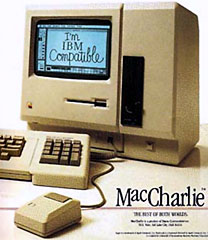Although PC compatibility isn’t a big deal since Apple’s transition to Intel CPUs in 2006, there is a long history of PC emulation and DOS cards that let Macs run PC operating systems and software. Dayna’s MacCharlie was the first solution to the “problem” of PC compatibility.

Dayna MacCharlie
Introduced on April 2, 1985, MacCharlie was taken by many to be an April Fools joke. MacCharlie was essentially a DOS PC that clipped to a Macintosh. The MacCharlie device had 256 KB of RAM, a double-sided 5-1/4″ floppy drive, and a “keyboard extender” that added all of the “missing” keys from a PC keyboard to the Mac’s keyboard. MacCharlie could be expanded to 640 KB of RAM (the most that PCs of that era could handle) and by adding a second 5-1/4″ floppy drive, which is the configuration of MacCharlie Plus.
There is only one cable connecting MacCharlie to the Mac (only the original 128K and later 512K “Fat Mac” are supported), a 9-pin serial cable that goes from the Mac’s printer port to an RS-422 port on MacCharlie, which also has a pass-through printer port for Apple’s ImageWriter.

While MacCharlie has PC hardware on the inside, it uses the Mac’s keyboard, mouse, and crisp display thanks to the MacCharlie software, which also allows transfer of files between the Mac and PC. Problem is, MacCharlie only supports text, not graphics, although reports are that it had a beautiful 80 character per line monospaced font.
The beauty of this approach is that very little information needed to go from the PC side, which runsn at 4.77 MHz, to the Mac – just the ASCII code for the text on the screen.
We have no information regarding how long MacCharlie was in production or how many were sold.
Details
- introduced 1985.04.02, shipped 1985.05.25 (and taken by s at US$1,195 ($1,895 for MacCharlie Plus)
- CPU: 4.77 MHz 8088 CPU
- ROM: 16 KB
- RAM: 256 KB, expandable to 640 KB
- serial ports: 2 RS-422 ports, 1 RS-232 port
- floppy: 5-1/4″ double-sided, optional second drive
- size (HxWxD): 13.8″ x 14.7″ x 10.8″
Online Resources
- Dayna MacCharlie, Vintage Mac World. The first page on the Web dedicated to the Mac’s first DOS compatibility hardware.
- The Strangest Classic Mac Peripherals I Have Ever Seen, Benj Edwards, Vintage Computing and Gaming, 2015.11.03. MacCharlie is the first item discussed.
- MacCharlie’s FrankenMac, Benj Edwards, Vintage Computing and Gaming, 2013.01.14
- MacCharlie ads, Mac Mothership. Scans of ads and brochures for MacCharlie.
- Meet MacCharlie, Cyrus Farivar, Mac User, 2006.04.11. “So I just came across something called the MacCharlie, a device built in 1985 that allowed the Macintosh of the day to run DOS.”
- Personal Computers; Linking Mac to the IBM PC, Erik Sandberg-Diment, New York Times, 1985.09.24. “MacCharlie will accept only software that does not use graphics. I didn’t expect to see color on the Macintish monochrome monitor, but a Mac without graphics?”
- Peripherals; Best of Both Worlds, Peter H. Lewis, New York Times, 1985.04.02. “MacCharlie will accept only software that does not use graphics. I didn’t expect to see color on the Macintish [sic] monochrome monitor, but a Mac without graphics?”
- MacCharlie, Wikipedia.

